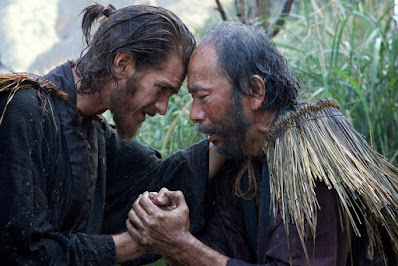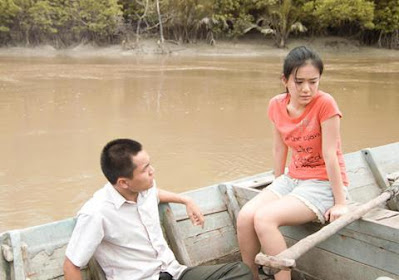1. Shoplifters (Hirokazu Koreeda)
Throughout his career, Hirokazu Koreeda has explored the nature of family, and has questioned traditional notions of the family unit. Shoplifters is perhaps Koreeda’s purest distillation of this inquiry into the family unit, and it is definitely his most powerful and emotionally impactful film since Like Father, Like Son. Shoplifters is a searing portrait of a family both brought together and ultimately torn apart by the demands of a harsh, uncaring society. I chose Shoplifters as the best of the decade because it’s the film that most resonated with me on a purely visceral and emotional level, and it also makes us think of what it means to be a family in modern society.
2. Silence (Martin Scorsese)
Martin Scorsese has made plenty of cinematically powerful films throughout his career, but Silence is the most effective of his recent films (although The Irishman was almost just as incredible, but more on that later). What makes Silence such an accomplishment is Scorsese stepping outside of his comfort zone to tell a less flashy and more creatively disciplined, pared down film. By reigning in his more extravagant impulses, which can result in admittedly great but also exhausting films like The Wolf of Wall Street, Scorsese is able to make his themes and dramatic gravitas more incisive in Silence.
3. River of Exploding Durians (Edmund Yeo)
River of Exploding Durians is a modern day A Brighter Summer Day. Like Edward Yang’s masterpiece, Edmond Yeo’s film is a complex and poetic exploration of how a country’s history shapes and affects a group of youth. With homages to Godard and the French New Wave, and various other cinematic allusions, Yeo creates an astonishing work of art that is also entirely his own, unique creation. Like the greatest works of cinematic art, River of Exploding Durians envelopes the viewer in a completely new vision of reality. The fact that it’s the first film from Yeo is even more astonishing.
River of Exploding Durians is a modern day A Brighter Summer Day. Like Edward Yang’s masterpiece, Edmond Yeo’s film is a complex and poetic exploration of how a country’s history shapes and affects a group of youth. With homages to Godard and the French New Wave, and various other cinematic allusions, Yeo creates an astonishing work of art that is also entirely his own, unique creation. Like the greatest works of cinematic art, River of Exploding Durians envelopes the viewer in a completely new vision of reality. The fact that it’s the first film from Yeo is even more astonishing.
4. The Dance of Reality (Alejandro Jodorowsky)
Alejandro Jodorowsky is most well-known for his highly surrealistic, hallucinatory early films Fando and Lis, El Topo and The Holy Mountain, but nothing he has made so far matches the dramatic impact of The Dance of Reality. The Dance of Reality, along with Endless Poetry, is Jodorowsky’s most personal film as it deals with his own youth. However, what separates The Dance of Reality from his other films is the unbridled passion felt in each and every frame. Watching The Dance of Reality almost puts you in an altered state of consciousness, as its poetic and powerful barrage of incredible set pieces and imagery flows in front of your eyes in a trance-like rhythm. I have seen many films throughout my life, but I have not really thing anything quite like The Dance of Reality.
Alejandro Jodorowsky is most well-known for his highly surrealistic, hallucinatory early films Fando and Lis, El Topo and The Holy Mountain, but nothing he has made so far matches the dramatic impact of The Dance of Reality. The Dance of Reality, along with Endless Poetry, is Jodorowsky’s most personal film as it deals with his own youth. However, what separates The Dance of Reality from his other films is the unbridled passion felt in each and every frame. Watching The Dance of Reality almost puts you in an altered state of consciousness, as its poetic and powerful barrage of incredible set pieces and imagery flows in front of your eyes in a trance-like rhythm. I have seen many films throughout my life, but I have not really thing anything quite like The Dance of Reality.
Sometimes you discover a great film which comes out of nowhere with little to no fanfare, and The Great Buddha + was one of those films. Although it was shortlisted for the Academy Awards Best Foreign Film category, The Great Buddha + never got a wide release or even much notice outside of its native country of Taiwan. This is unfortunate because The Great Buddha + is one of the funniest and most poignant films I have seen all decade about class consciousness (yes, I think it’s even better than the similarly themed Parasite). If you can find it, please seek out this film, as I’m sure you’ll be pleasantly surprised. It mixes dark comedy and social critique like the best films of Spike Lee and Billy Wilder. Huang Hsien-yao is surely a new talent to keep an eye on.
6. The Irishman (Martin Scorsese)
Martin Scorsese is well-known for making brutal and powerful gangster films, but no mafia film he has directed before has been quite like The Irishman. Unlike his previous crime films, The Irishman is a much more introspective and reflective film. While films like Goodfellas and Casino were almost celebratory in their depictions of gangsters (albeit in a cautionary way), The Irishman is Scorsese’s first film in which the lead character actually attempts to come to terms with the errors of his ways. In this way, The Irishman is Scorsese attempting to move away from the violent world of his prior films, and into a more enlightened realm.
7. Zero Dark Thirty (Kathryn Bigelow)
Throughout her career, Kathryn Bigelow has proved herself to be among one of the best action directors of all time. With Zero Dark Thirty, Bigelow has found a real life story that provides an epic backdrop for a harrowing tale of a woman determined to complete a single, history making mission against all odds. In this way, Zero Dark Thirty is like the Moby Dick of war films, and like Herman Melville’s epic story of obsession, Bigelow’s film is a labyrinthine, complex experience that has the feel of classic literature. Zero Dark Thirty culminates in one of the best action set pieces of all time, and solidifies Bigelow’s position among the pantheon of greatest directors of visceral cinema.
8. A Tiger in Winter (Lee Kwang-kuk)
Lee Kwang-kuk created one of the most realistic and bitterly funny portraits of the artistic process with A Tiger in Winter. Like the literal tiger that has escaped from the zoo of the film’s title, the two protagonists of A Tiger in Winter are self-adsorbed artists who destroy the lives of everyone in their paths. Lee understands that oftentimes great art comes from unpleasant and self-destructive personalities, and he both skewers and celebrates this bitter truth in his mordantly funny film.
9. Gone With the Bullets (Jiang Wen)
Martin Scorsese is well-known for making brutal and powerful gangster films, but no mafia film he has directed before has been quite like The Irishman. Unlike his previous crime films, The Irishman is a much more introspective and reflective film. While films like Goodfellas and Casino were almost celebratory in their depictions of gangsters (albeit in a cautionary way), The Irishman is Scorsese’s first film in which the lead character actually attempts to come to terms with the errors of his ways. In this way, The Irishman is Scorsese attempting to move away from the violent world of his prior films, and into a more enlightened realm.
Throughout her career, Kathryn Bigelow has proved herself to be among one of the best action directors of all time. With Zero Dark Thirty, Bigelow has found a real life story that provides an epic backdrop for a harrowing tale of a woman determined to complete a single, history making mission against all odds. In this way, Zero Dark Thirty is like the Moby Dick of war films, and like Herman Melville’s epic story of obsession, Bigelow’s film is a labyrinthine, complex experience that has the feel of classic literature. Zero Dark Thirty culminates in one of the best action set pieces of all time, and solidifies Bigelow’s position among the pantheon of greatest directors of visceral cinema.
Lee Kwang-kuk created one of the most realistic and bitterly funny portraits of the artistic process with A Tiger in Winter. Like the literal tiger that has escaped from the zoo of the film’s title, the two protagonists of A Tiger in Winter are self-adsorbed artists who destroy the lives of everyone in their paths. Lee understands that oftentimes great art comes from unpleasant and self-destructive personalities, and he both skewers and celebrates this bitter truth in his mordantly funny film.
9. Gone With the Bullets (Jiang Wen)
Gone With the Bullets, along with Let The Bullets Fly and Hidden Man, forms a trilogy of films by Jiang Wen that is probably the closest thing to modern day Federico Fellini that we are likely to see. Wen has proven himself to be a formidable filmmaker, and with each successive film, he has honed and developed his voice further. With Gone With the Bullets, Jiang Wen finally made perhaps the purest distillation of his claim as our new Fellini (along with Emir Kusturica). Like Fellini, Wen’s Gone With the Bullets is a carnivalesque celebration of life that is filled with exuberant set pieces and over the top characters. Wen’s outrageous characters and situations almost resemble commeddia dell’arte, with their delightfully rendered absurdity. This may also be the reason why Gone With the Bullets was not well received when it was released, as Wen is making films that recall an earlier time when art was more pure and less polluted by pointless cynicism.
10. Hanatagami (Nobohiku Obayashi)
Nobohiku Obayashi shocked the world with his debut film Hausu, which broke all cinematic conventions in the horror film genre, and his late career masterpiece Hanagatami is just as explosively innovative. Hanagatami is about a group of youth in a coastal Japanese village, and the effects of World War Two on their lives. However, the way Obayashi tells this intimate story is quite unlike anything you’ve ever seen. Hanagatami is pitched at a frenzied pace, and for over three hours Obayashi constantly experiments with narrative structure and visuals, creating a surrealistic portrait of youth that would have made Dali proud. Its experimentation with cinematic form reminds one of Seizun Suzuki’s Taisho Trilogy (Zigeunerweisen, Kagero-Za, and Yumeji), and like those films Hanagatami forms Obayashi’s own trilogy of films (along with Seven Weeks and Labyrinth of Cinema) which expand the language of cinema in exciting ways. From films like Hausu, Sada, and Hanagatami, Obayashi shows us the possibilities inherent within cinema for new methods of narrative form.












No comments:
Post a Comment